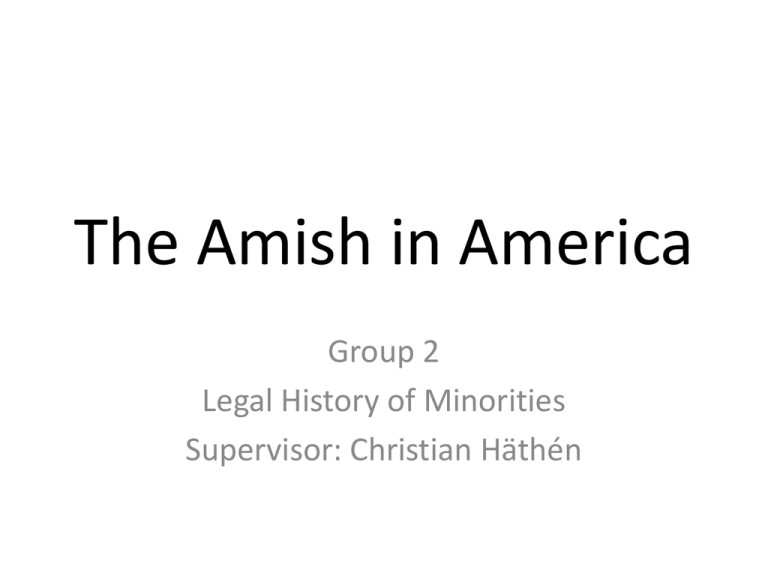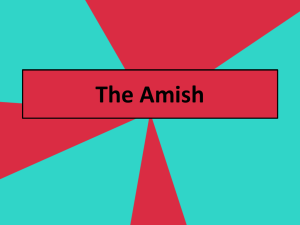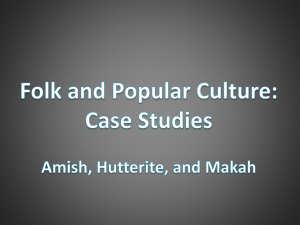History of the Amish
advertisement

The Amish in America Group 2 Legal History of Minorities Supervisor: Christian Häthén History of the Amish • The Amish are a group of traditionalist Christian church fellowships, originally of Swiss Anabaptist origins. • The Amish church began with a religious schism in Switzerland within a group of Swiss and Alsatian Anabaptists in 1693 led by Jakob Ammann. Those who followed Ammann became known as Amish. The Amish move to America • In the early 18th century, many Amish and Mennonites immigrated to the United States of America. • The migration was sparked by a number of factors 1. Religious persecution from other Christian groups 2. Wars 3. Poverty in Europe. • The Amish who settled in Pennsylvania mainly relocated to Lancaster County but other Amish subgroups moved to other prominent areas such as Indiana, New York and Michigan. The Amish split in America • The majority of Amish communities that were established in North America eventually relinquished their Amish identity. • 1860’s: Amish church conferences, Dienerversammlungen, established to discuss methods to adapt to modern society. • These meetings were boycotted by traditionalist Amish. • 2/3of the group chose to remain progressive and later united with thethMennonite Church in the early 20 century. • 1/3 who chose to retain the traditional way of life became known as Old Order Amish. The Amish in American Today • As of 2012, over 251,000 Old Order Amish live in the United States spread across 456 settlements, with increasing movement to the West. • Today, the most traditional descendants of the Amish continue to speak Pennsylvania German, also known as "Pennsylvania Dutch". • Old Amish live by the code of Ordnung which stresses the virtues of humility, obedience and simplicity. Amish Religion History • It is a branch or division of the Swiss Anabaptists and is closely related to the Christian religion. • However, there are some differences: - Scripture based - Separation of church and state - Adult baptism • Called upon by God to lead a “simple life of faith, discipline, dedication and humility”. • Individual practice- not a display to others. Amish Church Services • Held in community members’ homes every other Sunday. • It’s a time to worship God, preserve community tradition and renew ones faith. • It consists of chanting and singing hymns from the Ausbund- one of the most important books to the Pennsylvania Amish. • These hymns are passed down from generation to generation orally. Rumspringa • When an Amish child turns 16, they can choose to experience the outside world. • After this time, the child decides whether or not to return back to their Amish community. • They are then baptized as a full member of the community. Amish Lifestyle • “Not conformed to this world” • They separate themselves by living in small communities and are different in their: - Language: Pennsylvania Dutch, High German and English. - Dress: simplistic and distinctive clothing, reflecting their “faith, purity and social separation from the world”. - Education: formal education up until the eighth grade then vocational schooling. - Family work roles: each family member plays a crucial role and contributes to the family as a whole with work divided by gender roles. - Rules: governed by Ordnung or set of unwritten rules. - Amish shunning The Amish and the Laws of the United States How the Amish use the law • The Amish accept the necessity of government but try to minimize their interactions with it „strategy of withdrawal“ They pay state and federal income taxes as well as real estate taxes Some vote in elections but holding public office is forbidden for them They refuse jury duty The Amish and the Laws of the United States Their view on courts and lawsuits • They avoid going to court • There is a taboo of civil law suits the Amish rely on their own congregational courts • Instead of reporting crimes the Amish normally deal with them according to Amish church discipline The Amish and the Laws of the United States Exemptions from U.S. laws • The Amish formed the National Steering Committee to negotiate with the government • They were granted a great account of religiously based exemptions to generally binding laws • The two most important are: The freeing of the obligation to send their children to High School (“Wisconsin v. Yoder” –Case) The exemption from the payment of social security-related taxes Laws v. Reality Schooling Laws v. Reality Schooling • Wisconsin v. Yoder – 1972 • Pennsylvania school – The Amish vocational school (1955) • The Hershberger case Laws v. Reality Compulsory insurance • Responsibility of the state for the elderly – a denial of the faith • Exemptions Laws v. Reality Medical attention • Forced medical treatment • Expensive medical care • Higher pain threshold Laws v. Reality Do Amish Use the Law? • Rebellion against the system – un-Christian and unthinkable • Forbidden to take oaths, serve on juries or collect debts on courts (The Witness 1985) • No reports of the violence • Amish beard cutting case Laws v. Reality Do Amish Use the Law?








